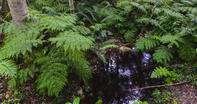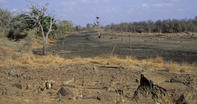Forests and Oceans
Carbon “sinks”, in the shape of forests and the ocean, strip about 40 percent of our annual CO2 emissions from the atmosphere. Our oceans absorb carbon from the atmosphere in two ways.

Firstly marine algae absorb CO2 just as our plants do on land and, through photosynthesis, turn that into carbohydrates which they then use as food to grow. This is how carbon is taken from the atmosphere and diverted into the marine food chain. This is the ocean’s absorption of “organic” carbon. Another way, the absorption of “inorganic” carbon, is through a process of gas “dissolving” in water.
The resulting chemical reaction decreases the pH of the ocean, pushing it towards a more acidic state. Between 1750 and 1994, the ocean sucked about 118 gigatons of carbon from the atmosphere through both these methods. Each year it strips another 2.2 gigatons of carbon out of the atmosphere – that’s a nice chunk out of the 9 gigatons of carbon emitted by our activities each year.
Carbon Saturation
But there’s only so much carbon that our oceans can take up before they become saturated. Should our oceans reach a saturation point, further absorption of atmospheric carbon will slow down or halt entirely, resulting in an accelerated build up of atmospheric carbon dioxide.
This, in turn, will speed up temperature hikes and hasten changing climate. RealClimate.org, the reputable climate change education website, reported in November 2007 that “warming in the coming century could be increased by carbon cycle feedbacks, by 25 to 75 percent or so”.
Alarmingly, it looks as though that rate of absorption is already slowing, with the Intergovernmental Panel on Climate Change (IPCC) calculating that carbon absorption is slower now than it was three decades ago. However CO2 sinks on land might become saturated before the oceans do, perhaps even by 2040.
Sobering Words

Al Gore, in An Inconvenient Truth, pointed out that a shift in average temperature of just 5°C was the difference between today and Canada lost under a kilometre and a half of ice during the last ice age. Mark Lynas, in his book Six Degrees, gives the other side of that extreme: the last time Earth was an average of 4°C warmer than it is today, there was no ice held captive at the poles.
Sobering words indeed, particularly since we are already halfway there (we’re committed to a 2°C rise in temperature because of the inertia in the system). If we continue pumping more greenhouse gas pollution into the atmosphere, while removing the natural carbon sinks or filling up those that remain, we may bring about irreversible change.
The World Wildlife Fund’s Peet du Plooy, writing in Africa Geographic, said that if we continue to disrupt the climate system and natural carbon sinks, and if we do it sufficiently, we could trigger runaway global warming and find ourselves on a “headlong rush (which) may cause a rise in temperatures of 6°C to 10°C and plunge the planet into conditions last seen hundreds of millions of years ago when extinctions occurred on a massive scale.”
By Leonie Joubert